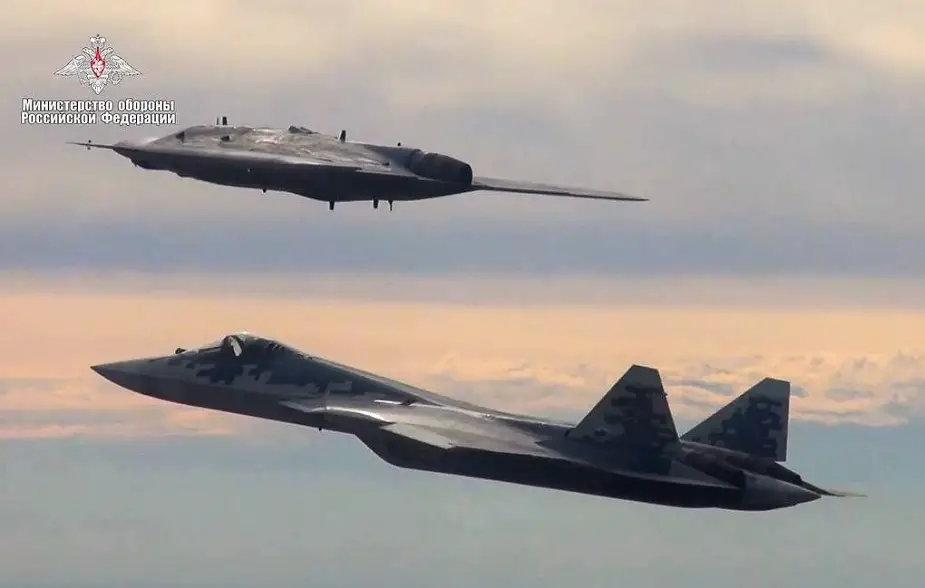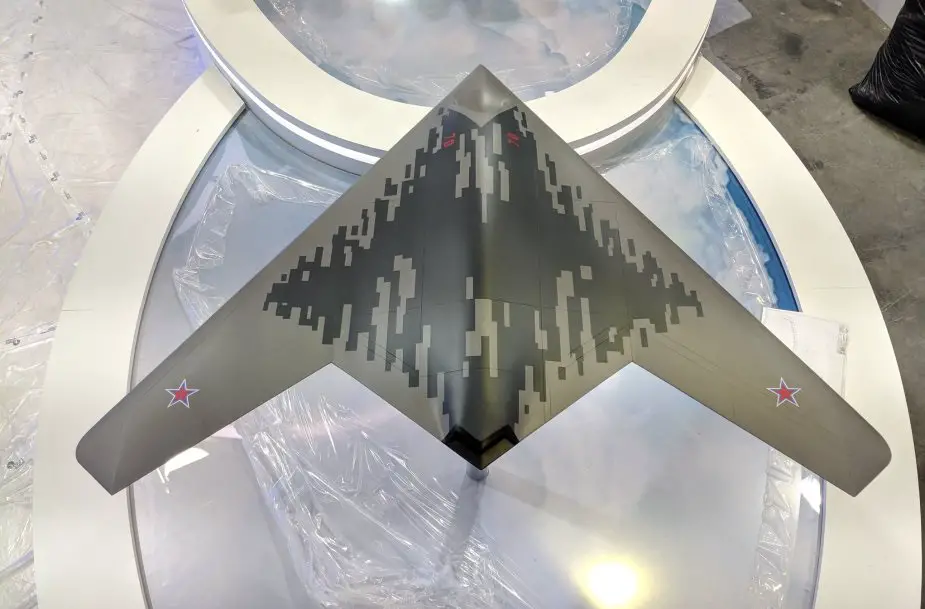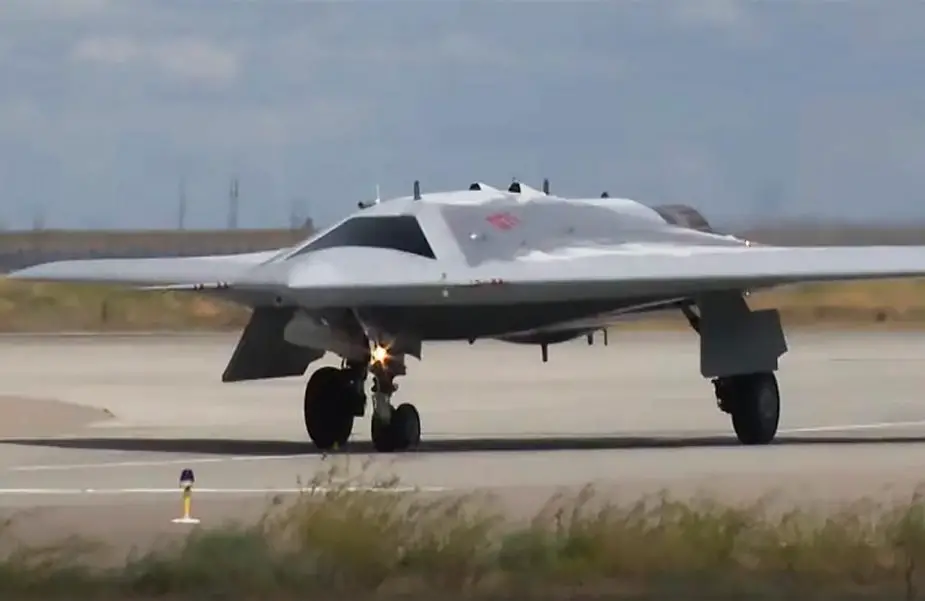Multirole fifth-generation Su-57 fighter jets will operate together with heavy Okhotnik reconnaissance-combat drones. They are to be united into combined regiments to increase the capabilities of the Aerospace Forces. Drones and fighter jets will destroy important targets in hostile rear and remain unnoticed. The current technical development level can cope with the task, the Izvestia daily writes.
Follow Air Recognition on Google News at this link
 Su-57 and Okhotnik flight (Picture source: Russian MoD)
Su-57 and Okhotnik flight (Picture source: Russian MoD)
The Russian Defense Ministry is considering the integration of heavy Okhotnik into the armed forces. Ministry sources said the drones are likely to join Su-57 regiments. There will be one drone squadron per 2-3 Su-57 squadrons. They will operate together and engage a new tactic and the capabilities of artificial intelligence (AI) elements.
Ministry sources said the new scheme expands the combat capabilities of the Russian Aerospace Forces. Su-57 and Okhotnik will deliver precision strikes at major hostile objects.
The military already enjoy a positive experience of uniting drones with fighter jets. A squadron of Forpost reconnaissance drones joined the 689th fighter jet regiment in Kaliningrad. In Crimea, a drone unit operates in the 318th combined air regiment.
In December 2020, Rostec CEO Sergey Chemezov said the Defense Ministry had asked to accelerate the creation of combat Okhotnik drones. He recalled the drone had been tested together with a Su-57.
First Deputy Chair of the Russian Military-Industrial Commission Andrey Yelchaninov said batch procurement of S-70 had been included into the arms program for 2024-2033, which is being drafted. He said joint trials of Su-57 and the heavy drone test reciprocal information transmission, target distribution in flight, intervals and distances, and antimissile maneuvers. In future, the pilot will be able to control several drones at a time and distribute missions among them.
 The Sukhoi S-70 Hunter UAV at MAKS 19. (Picture source: MuxelAero/Twitter account)
The Sukhoi S-70 Hunter UAV at MAKS 19. (Picture source: MuxelAero/Twitter account)
Three Okhotnik prototypes are being built. They will join the test program in 2022-2023.
A Su-57 prototype accompanied Okhotnik in one of the first flights. The Defense Ministry said the low-signature drone expanded the radar field of the fighter jet and guided its missiles thus keeping the jet outside the hostile air defense zone.
The final Okhotnik option will differ from the tested one. The Defense Ministry and the Sukhoi Company signed a contract for S-70 R&D in late 2019. It is to be completed in late 2025. The final option will have a flat engine nozzle to decrease radar and heat signature.
The 20-ton Okhotnik is one of the biggest and most powerful drones in the world. Its carrying capacity and the size of the bomb compartment allow engaging any air weapon, which can be fired also by Su-57.
“Such a scheme can work in modern conditions,” expert Dmitry Boltenkov said. “Remote control of aircraft from another aircraft was attempted yet in World War Two. However, the technologies were raw. Now the pilot of the fighter jet will not be distracted in order to control the drone. It is suffice to set a mission and the drone will fulfil it independently with sophisticated algorithms and artificial intelligence elements,” he said.
Even satellite channels inevitably delay the signal, which impedes the engagement of big drones in air combat in a rapidly changing situation. Humans can better analyze, while direct interaction of a drone and a fighter jet eliminates delays, the expert said.
The Defense Ministry has already accepted the first serial Su-57 into service. Another 22 jets have to be supplied by the end of 2024. Seventy-six fifth-generation fighter jets have been contracted up to 2028 for three air regiments, the Izvestia said.
 The Sukhoi S-70 Hunter UAV (Picture source: Russian ministry of defence)
The Sukhoi S-70 Hunter UAV (Picture source: Russian ministry of defence)
About the Sukhoi S-70 Hunter UCAV:
The flying wing unmanned combat air vehicle (UCAV) is being developed under the Udarno-Razvedyvatelnyi Bespilotnyi Kompleks (URBK), or Strike-Reconnaissance Unmanned Complex, program with Sukhoi as the project lead. The Russian Defense Ministry reportedly ordered the design bureau to begin the development and construction of the Okhotnik prototype in October 2011.
The S-70 is similar in appearance to flying-wing UAVs built by several nations, including China’s Sharp Sword, France’s Dassault Neuron, the UK’s BAE Systems Taranis and the USA’s Northrop Grumman X-47B. The flying wing shape inherently has a lower radar cross-section, although Russia says its jet is also coated in radar-absorbent paint.
The Sukhoi S-70 Hunter is way larger than its Western counterparts like Dassault nEUROn and Northrop Grumman X-47B. With 20 meters in wingspan and a length of 14 meters, its mass is supposedly around 20 tons (against 4.9 for the Dassault nEUROn and 6.3 for the Northrop Grumman X-47B). It is expected to fly at a speed of 1,000 km/h, for a range of 6,000 km and its two internal bays should embark up to 2.8 tons of weapons.
According to the Ministry of Defence, S-70 Okhotnikis powered by an AL-31 turbojet engine and is equipped with electro-optical targeting, radio, and “other types of reconnaissance equipment”.
On August 7 , Ministry of Defence of the Russian Federation released a video of the maiden flight of the Russian heavy strike S-70 Okhotnik UAV.
© Copyright 2021 TASS. All rights reserved. This material may not be published, broadcast, rewritten or redistributed.
















